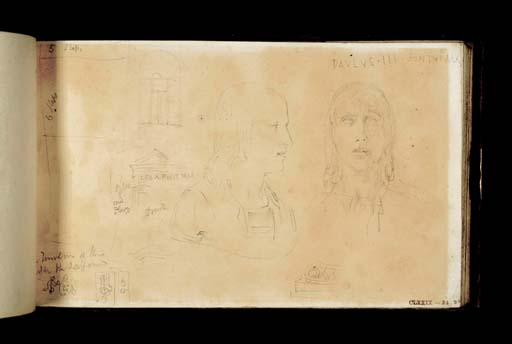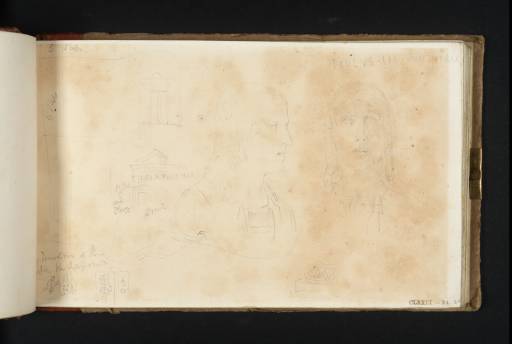Joseph Mallord William Turner Details of the Decorations of Raphael's Loggia in the Vatican: including Two Sketches of the Bust of Raphael by Alessandro d'Este 1819
Image 1 of 2
-
 Joseph Mallord William Turner, Details of the Decorations of Raphael's Loggia in the Vatican: including Two Sketches of the Bust of Raphael by Alessandro d'Este 1819
Joseph Mallord William Turner, Details of the Decorations of Raphael's Loggia in the Vatican: including Two Sketches of the Bust of Raphael by Alessandro d'Este 1819 -
 Joseph Mallord William Turner, Details of the Decorations of Raphael's Loggia in the Vatican: including Two Sketches of the Bust of Raphael by Alessandro d'Este 1819 (Enhanced image)Enhanced image
Joseph Mallord William Turner, Details of the Decorations of Raphael's Loggia in the Vatican: including Two Sketches of the Bust of Raphael by Alessandro d'Este 1819 (Enhanced image)Enhanced image
Joseph Mallord William Turner,
Details of the Decorations of Raphael's Loggia in the Vatican: including Two Sketches of the Bust of Raphael by Alessandro d'Este
1819
Joseph Mallord William Turner 1775–1851
Folio 24 Recto:
Details of the Decorations of Raphael’s Loggia in the Vatican: including Two Sketches of the Bust of Raphael by Alessandro d’Este 1819
D14969
Turner Bequest CLXXIX 24
Turner Bequest CLXXIX 24
Pencil on white wove paper, 112 x 186 mm
Inscribed by the artist in pencil ‘5 Steps’ top left, and ‘6 Steps’ top left, parallel with left-hand edge, and ‘The Invention of this | like the Raffaels’ and ‘G’ and ‘G’ bottom left. Also ‘LEO X PONT MAX’ and ‘Blue | and Flowers’ and ‘Fruit’ within sketch to left of shoulder of bust, and ‘PAVLVS . III . PONT . Max’ top left
Inscribed by an unknown hand in pencil ‘24’ bottom right
Stamped in black ‘CLXXIX 24’ bottom right
Inscribed by the artist in pencil ‘5 Steps’ top left, and ‘6 Steps’ top left, parallel with left-hand edge, and ‘The Invention of this | like the Raffaels’ and ‘G’ and ‘G’ bottom left. Also ‘LEO X PONT MAX’ and ‘Blue | and Flowers’ and ‘Fruit’ within sketch to left of shoulder of bust, and ‘PAVLVS . III . PONT . Max’ top left
Inscribed by an unknown hand in pencil ‘24’ bottom right
Stamped in black ‘CLXXIX 24’ bottom right
Accepted by the nation as part of the Turner Bequest 1856
Exhibition history
1869
Second Loan Collection selected from the Turner Bequest, various venues and dates, 1869–1931 (no catalogue but numbered 122c).
References
1909
A.J. Finberg, A Complete Inventory of the Drawings of the Turner Bequest, London 1909, vol.I, p.527 as ‘Two sketches of a bust of “Paulus III.,” &c. No.122c, Second Loan Collection’.
1984
Cecilia Powell, ‘Turner on Classic Ground: His Visits to Central and Southern Italy and Related Paintings and Drawings’, unpublished Ph.D thesis, Courtauld Institute of Art, University of London 1984, pp.116, 148, 235, 239, 410, reproduced pl.84, as ‘Two sketches of the bust of Raphael by Alessandro d’Este in the Vatican loggia (the inscriptions Paulus III, etc. are from above the doorways of the loggia)’.
1987
Robert E. McVaugh, ‘Turner and Rome, Raphael and the Fornarina’, Studies in Romanticism, no.26, Autumn 1987, p.372.
1787
Cecilia Powell, Turner in the South: Rome, Naples, Florence, New Haven and London 1987, pp.62, 117, reproduced pl.67, p.62, as ‘Sketches of the bust of Raphael by Alessandro d’Este (1787–1826), Vatican loggia, Rome’.
1991
Ian Warrell, ‘R.N. Wornum and the First Three Loan Collections: A History of the Early Displays of the Turner Bequest Outside London’, Turner Studies, Summer 1991, vol.11, no.1, p.45, no.122c.
2008
James Hamilton, Nicola Moorby, Christopher Baker and others, Turner e l’Italia, exhibition catalogue, Palazzo dei Diamanti, Ferrara 2008, pp.49 and 91 note 70.
2009
James Hamilton, Nicola Moorby, Christopher Baker and others, Turner & Italy, exhibition catalogue, National Galleries of Scotland, Edinburgh 2009, pp.52, 151 note 70.
2009
David Solkin (ed.), Turner and the Masters, exhibition catalogue, Tate Britain, London 2009, pp.226 note 36, 229 note 1 under no.63.
2010
David Solkin and Guillaume Faroult (eds.), Turner et ses peintres, exhibition catalogue, Galeries nationales, Grand Palais, Paris 2010, pp.53, 60 note 35, 196, 262 note 12.
2011
Nicola Moorby, ‘Turner’s Sketches for “Rome from the Vatican”: Some Recent Discoveries’, Turner Society News, no.115, Spring 2011, pp.5, 10 note 20.
One of the most significant series of studies dating from Turner’s 1819 trip to Rome was the sequence of on-the-spot pencil sketches relating to the Loggia of Raphael, a colonnaded porch on the second floor of the Vatican’s Apostolic Palace, decorated by Raphael (1483–1520) and his studio. Turner made a closely detailed visual record of the loggia, particularly concentrating on the southern end of the interior and the decoration of the first three bays and window arches, see folios 13 verso–21 (D14955–D14965). From these drawings evolved the artist’s first finished oil painting following his Italian tour, the vast canvas Rome from the Vatican. Raffaelle Accompanied by La Fornarina, Preparing his Pictures for the Decoration of the Loggia exhibited 1820 (Tate, N00503).1 This page contains several sketches recording various components within the loggia, and hence relating to the evolution and composition of the painting.
As first identified by Cecilia Powell, the principal subject on the right-hand side of the sheet is a portrait bust of the Renaissance master, Raphael (1483–1520) by Alessandro d’Este (1787–1826), the son of the Director of the Vatican Museums.2 This sculpture had recently been given to the Vatican by Antonio Canova (1757–1822), and had been displayed on a plinth at the southern end of the loggia to commemorate Raphael’s role in the creation of the decorative fresco scheme.3 Turner has depicted it in two variant views, from the front and in three-quarter profile. The inscription in the top right-hand corner above the drawing, ‘PAULUS.III.PONT.MAX’, comes from the lintel of the fictive marble frame painted around the real marble door frame behind the bust.4 Powell has suggested that it may have been the presence of this statue which provided Turner with the germ of the idea for depicting the figure of Raphael in Rome from the Vatican, although the unusually focused and comprehensive nature of the related loggia sketches strongly suggests that the artist had already conceived the idea for the picture when he visited the Vatican and that he was specifically gathering material with the concept already well advanced in his mind. In other drawings he also showed the bust within its architectural context, see folio 13 verso (D14955), and the Rome C. Studies sketchbook (Tate D16368; Turner Bequest CLXXXIX 41), although in the final composition the plinth stands empty since the figure of the artist is made flesh within the foreground. Turner still seems to have made use of his studies of the bust however, as a source for Raphael’s features.5
The sketches to the immediate left of the bust of Raphael represent one of the marble pedimented frames above the aedicula from a bay along the interior wall of the loggia. These bear the inscription ‘LEO.X.PONT.MAX’.6 The study in the bottom left-hand corner meanwhile appears to represent a detail from the door on the west wall of the first bay at the southern end of the loggia.7 The meaning of the diagrammatic details in the top left-hand corner is currently unidentified. Further studies related to Rome from the Vatican can be found on folios 21 verso and 25–26 (D14966 and D14970–D14972).
This page was selected by Ralph Nicholson Wornum for the Second Loan Collection, a group of sixty-two works exhibited in the provinces during the late nineteenth and early twentieth centuries.8 It was removed from the sketchbook and displayed within a mount. Consequently, like the other works included in those tours, the drawing has suffered badly from over-exposure to light and the paper has yellowed considerably.
Martin Butlin and Evelyn Joll, The Paintings of J.M.W. Turner, revised ed., New Haven and London 1984, no.228.
Bernice F. Davidson, ‘Pope Paul III’s Additions to Raphael’s Logge: His Imprese in the Logge’, The Art Bulletin, vol.61, no.3, September 1979, pp.392–3.
See Davidson 1979, p.393 and Nicole Dacos, Le Logge di Rafaello: Maestro e bottega di fronte all’antico, Rome 1977, Tav.LV, ‘a) Pennacchi II.1’.
See the watercolour by Giovanni Volpato, reproduced in colour in Giorgio Marini, Nicole Dacos, Michel Hochmann, Annie Gilet et al., Giovanni Volpato: Les Loges de Raphaël et la Galerie du Palais Farnèse, exhibition catalogue, Musée des Beaux-Arts de Tours 2007, no.2, p.129, as ‘Lunette et Porte de la travée I’.
Verso:
Blank
Inscribed by ?John Ruskin in blue ink ‘24’ bottom left, inverted
Blank
Inscribed by ?John Ruskin in blue ink ‘24’ bottom left, inverted
Nicola Moorby
January 2010
How to cite
Nicola Moorby, ‘Details of the Decorations of Raphael’s Loggia in the Vatican: including Two Sketches of the Bust of Raphael by Alessandro d’Este 1819 by Joseph Mallord William Turner’, catalogue entry, January 2010, in David Blayney Brown (ed.), J.M.W. Turner: Sketchbooks, Drawings and Watercolours, Tate Research Publication, December 2012, https://www

